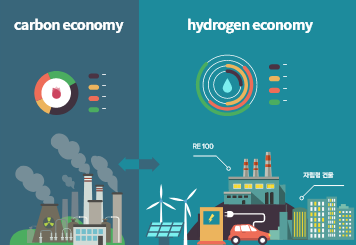carbon resources
oil, carbon, gas, etc.
|
decarbonization center
|
centralized
energy supply
|
decentralized
energy supply
|
|
resource development and energy security War
|
securing technological competitiveness and competing with economy of scale
|
|
greenhouse gas, air pollutant dispose
CO2, NOx, SOx
|
eco-friendly with no greenhouse gas emissions
By-product = water (H2O)
|
[ Energy paradigm shift ]
The end of the fossil fuel era, competition for technological supremacy with hydrogen energy begins
Beyond the limits of renewable energy such as solar and wind power
Energy paradigm shift with hydrogen energy
73% of global emissions are from energy-consuming industries (24%), buildings (17%) and transport.
(16%), followed by transportation (12%) and steel (7.3%) in detail, in the case of Korea
40% of the power generation sector, 13% each of the steel and transportation sectors, and 6% of the chemical sector emits exhaust gas.
The steel sector shows a high emission ratio.
As an alternative energy to fossil fuels, which are the main culprits of global warming, nuclear power generation eliminates high-level radioactive waste for 100,000 years.
There is a problem that it must be stored for a while and requires limited resources such as uranium, and solar and wind power
Renewable energy can damage the existing power grid because the generation output is not constant depending on the amount of sunlight and weather.
There is a high concern that there is When more electricity than demand is put into the transmission and distribution network or when there is little generation
A ‘blackout’ situation may occur, fires caused by large-scale energy storage systems (ESS), and many sites
The problems you need follow.
For this reason, it is an eco-friendly energy that can replace carbon energy, which is an infinite resource and exceeds the demand for electricity.
The supplied power can be stored as hydrogen, transported in liquid or gas, and converted into electricity through a fuel cell when needed.
The energy paradigm is changing to hydrogen energy that can be converted and utilized.
 [ UN IPCC - Intergovernmental Panel on Climate Change Report ]
[ UN IPCC - Intergovernmental Panel on Climate Change Report ]






